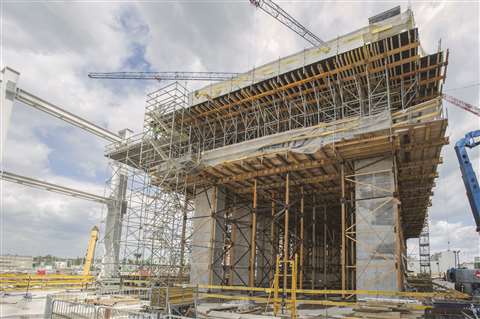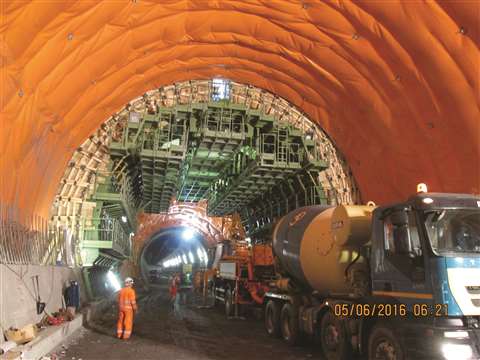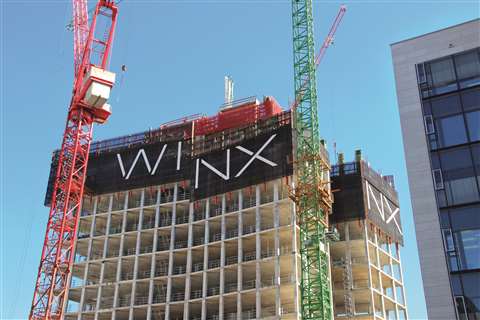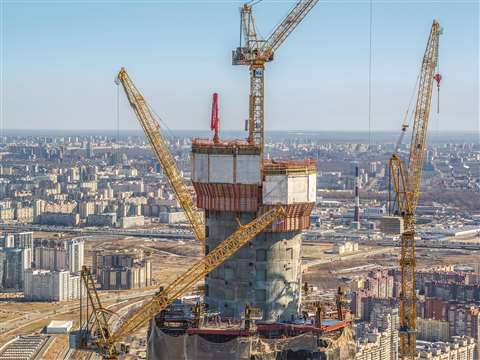Falsework & formwork: True to form
06 November 2017

Falsework and formwork work hand-in-hand to provide almost unlimited configurations that can be adapted to an array of tasks.
Its versatility is exemplified by Alsina, a Spanish-based company whose falsework and formwork is currently being used in a variety of projects across Europe.
To give some examples, in Spain, Alsina is one of the collaborators working on the new Poema del Mar Aquarium, in the port of Las Palmas de Gran Canaria. It is said to be the largest complex of its type in Europe and entails the construction of a building with an area of 8,500m2.
Alsina’s solutions have been used to create the aquarium itself, which was designed to hold 8 million litres of water, and the 20m-high, 7,600m2 façade, made of white concrete, and designed to contain hollow areas that will be installed with LED lights.
In Poland, the Rytter Elektrownia Lipki water power plant is being constructed. Alsina has supplied its Alisply walls, CL-160 climbing system, multiform formwork system, and HT beams to the project.
The one-sided concrete walls, which are 11m high, incorporate some unusual shapes. Alsnia’s Alisply range includes several recoverable formwork systems for the construction of walls and columns. For this particular job, Alisply walls were used in conjunction with Dywidags that were welded to the steel Larsen wall in order to hold the Alisply straight formwork system.
The use of plywood in the Alisply range, rather than metal, was said to offer the advantages of lower weight, higher concrete quality, increased performance and greater resistance to inclement weather.
Railway line
In Italy, the company has been involved in the construction of the Arcisate-Stabio railway line, which will connect Malpensa airport in Italy with Switzerland.
Along its 8km length, Alsina has participated in the building of Gladden station, on the border between the two countries, the GA03 tunnel to Induno Olona in Italy, all the water traps and several retaining walls.
For the GA03 tunnel, Alsina’s AR-80 shoring system allowed supporting trusses to be used, which enabled vehicles to pass beneath it without interruption.
To achieve the particular shape of the vault, the structure was fixed using the company’s multiform system. Formwork stripping was then carried out using manual lathes operated from above the formwork structure. This allowed quick recovery and kept the workers safe during the procedure, said Alsina.
Meanwhile, Cifa has also been using falsework and formwork on rail projects. The Italian-based company has been involved in work on a number of new European railway lines to create high-speed train connections across the region, along with intermodal hubs connecting Europe with other continents.
The geography has necessitated the use of tunnels. For this, Cifa’s equipment has been used in Spain, Switzerland, German, Norway and Italy, including the Brenner Base Tunnel.
These tunnels required new project models with respect to safety standards, to make them suitable for high-speed trains. For example, the lines had to be double-piped, separating the two directions of travel, and sections had to be widened to create caverns for safety exits.
Cifa engineered self-supporting intersection formworks for setting up cross vaults with reinforced portals that could be cast at the same time as the line tunnels.
In the widened areas, 18 x 20m metallic formworks were moved using one of Cifa’s self-propelled, tyred travellers. This allowed the creation of monolithic cross-vaults.
In some areas, where the composition of the rock was stronger, the two parallel tunnels were dug at different rates, leading to a situation in which there was an asymmetry of structural load. This required extra precautionary measures and reinforcements.

Power plant
A power plant in Poland, the Jaworzno III, is under construction, and Spanish-based Ulma has been providing comprehensive support, including engineering solutions, falsework and formwork, and supervision for the construction of both the powerhouse and the electrical and mechanical systems centre.
Building a powerhouse is said to be one of the most demanding aspects of creating a power plant. Here, both the interior columns and the perimeter walls, which were 6.6m high and 50cm thick, were poured using Orma formwork, designed to withstand pouring pressures of up to 80kN/m2.
The columns were poured using 132cm-wide Orma column panels, which allowed sections as large as 120 x 120cm to be poured without the use of any auxiliary supports or walers.
Ulma’s Enkoflex beam system, supported by T-60 shoring, was used to pour the subterranean slab with a thickness ranging from 30 to 40cm.
The first above ground slab stood at a height of 15m, with a thickness that varied between 2.38 and 3.9m. It was shored by a two-level structure employing both MK and T-60 shoring.
The first level was composed of MK-360 shoring structures that were more than 7.5m tall, with plan spaces ranging from 1.5 x 2m to 4 x 2.5m. Part of the structure was set on metal beams to ensure an even load distribution. The second level was made of T-60 towers that were 3m tall, set on HEB 320 and HEB 200 ledgers and joists.
As for the electrical and mechanical systems centre, the seven-storey building had a quasi-rectangular floor plan measuring 13.3 x 81.75m, and a height that varied from 30 to 46m. BMK climbing brackets were used in combination with Orma panel formwork to build the walls.
The construction required 33 individual bracket assemblies with platforms underneath for cone recovery, and the scaffolding for rebar placement was fixed to the BMK brackets to ensure worker safety.
Enkoflex and MK tables were used as formwork for the slabs and beams. The MK table system featured MK walers that allowed Aluprop props to be folded and locked, making transport between levels simpler and more efficient. T-60 towers were used for the slabs at heights reaching up to 9.5m.
The wall formwork was provisioned with safety platforms on both sides, and in two formats – standard systems with metal platforms pre-mounted on brackets, and Ulma’s new safety platform for wall construction, SBU. This system allows working platforms to be fitted with certified Brio scaffolding components, and its modularity makes it flexible.
Urbanisation
With urbanisation a growing trend, the United Nations has forecast that by 2050 almost 70% of the world’s population will live in cities, so high-rise building is likely to increase.
According to statistics released by the Council on Tall Buildings & Urban Habitat, in 2016 there were just over 1,160 completed buildings in the world that were at least 200m tall. The corresponding figure for 1960 was just 15 buildings.
Over the past 40 years, Austrian-based Doka has come to specialise in formwork solutions for high-rise structures, and it is currently working on its 1,000th high-rise – the Central Park Tower in New York City, US, which it is set to be the world’s tallest residential building.
Every high-rise is different in its structural design and building materials, calling for unique formwork solutions. However, a feature common to many is a cast-in-place concrete core, or cores, for vertical accessibility inside the finished structure. So, in most cases it makes sense to use a climbing system on these cores.
This usually comprises a combination of falsework and formwork that is either lifted by crane or is able to climb by itself to the next pouring section.
There are three main systems that have become established in the market – profile-guided climbing systems, crane-independent climbing systems with hydraulic drive, and platform systems.
According to Doka, it is vitally important for the formwork supplier and the project owner to start working together during the project development phase to take into account the specific needs of the project and to plan thoroughly to ensure fast and safe operations.
Factors such as cycle time, construction method, type of reinforcement and site equipment all have ramifications for the formwork solution, from props to the provision of specialists for training the site crew.
One advantage of using climbing systems that remain connected to the structure is that they can be used safely in very windy conditions.
Hydraulic climbing
Another tower being constructed – using hydraulic climbing systems – is the Winx Tower in the new Maintor district of Frankfurt, Germany.
Situated on the bank of the River Main and standing as the centrepiece of the new district, the 110m-high tower will have 30 storeys. It also comprises a seven-storey portal building measuring 26m in height.

The Meva Guided Screens (MGS) and Meva Guided Climbing (MGC) systems used in its construction were required by contractor Bam Deutschland to be unimpaired by wind and weather conditions.
With their closed housing, the two climbing systems provided protection from the elements and seamless fall protection. And the fact that they were secured to the building by means of guiding profiles during the entire construction work meant that they could climb at wind speeds of up to 72km/h.
The MGS system was used on the façades of the tower, while the core of the high-rise buildings were climbed using the MGC guided climbing system with Mammut wall formwork and integrated shaft platforms.
The MGS system fully enclosed all four sides of the building, which had an asymmetrical ground plan, obtuse angles on all sides and inset balconies in the middle of the short sides. This was achieved using 31 MGS units up to 6.81m in length and a material platform on each of the long sides to allow material to be supplied and removed by crane. Also, a special platform was located on both short sides of the building to bridge the prefabricated balconies.
The housing covered three floors and protected the workers when performing slab formwork tasks.
The MGS units consisted of vertical guiding profiles with horizontal square timbers, to which the trapezoidal sheets were attached. The guiding profiles were supported in the suspension shoes and slid upwards through these when climbing. The suspension shoes were anchored in pairs at the slab edge and could be adjusted with millimeter precision – even during climbing, if required.
A similar clamping and sliding method was used for the MGC climbing system and the shaft platforms, though they used climbing shoes that were anchored in the walls.
Eight MGC units with lengths of up to 8.47m, and 16 shaft platforms were used to climb the two-section core of the high-rise building.
The 3.74m-high walls were poured using Mammut wall formwork, which comprised of 2.5m-high panels, each height-extended with a 1.25m-high panel. The fully-enclosed MGC units were equipped with pouring platforms on top of the wall formwork.
Europe’s highest
In St Petersburg, Russia, the Lakhta Centre is set to be the highest skyscraper in Europe, standing at 462m, and German-based Peri has been providing the contractor with support throughout the project, from formwork solutions for the foundations to complex shoring arrangements.

One of the primary challenges of the high-rise building was its continuous, spiral-shaped rotation and the subsequent constantly changing slab areas. Foundations were also an issue, given the fact that the structure was located on the coast, where the ground conditions were unstable.
A project-specific solution had to be developed for the foundations, which involved positioning the tower on 264 piles that reached to a depth of 82m. Furthermore, the foundations were constructed in the form of a five-cornered box with a footprint of 5,600m2 and a height of 16.5m.
From the inner circular core, ten stiffening shear walls extended radially to the five external walls. These shear walls, in the form of double T-girders, connected the two horizontal slabs to create a large, load-bearing box.
When concreting the foundations, it was recorded by the Guinness Book of Records as the biggest continuous concrete pour ever carried out – 19,624m3 were poured.
For the foundation walls, Peri used a concept based on Domino Panel formwork.
For the tower itself, an ACS climbing system was combined with Vario GT 24 girder wall formwork to create the core. This meant the formwork could be lifted quickly to the next casting segment without the use of a crane and regardless of the weather conditions.
The girder wall formwork was designed to be flexible so that the construction team was able continuously to adjust the formwork to suit the changing building geometry.




